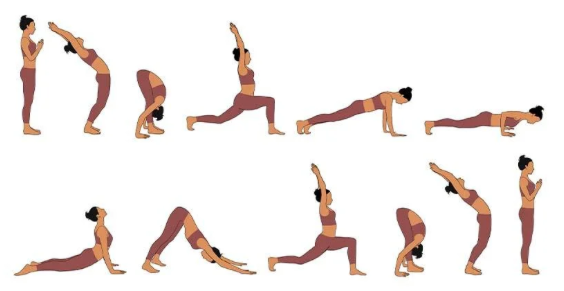Making the humble Sun Salutation work for YOU!
- Imogen North
- 23 hours ago
- 3 min read
The Sun Salutation, or Surya Namaskar, is one of the most recognisable sequences in our contemporary vinyasa asana practice. It’s a simple yet powerful sequence of poses where we synchronise movements with the breath. You will normally see traditional salutations practiced in the first half of a yoga class not just to build warmth but also to establish rhythm and to give the mind a focus. Although there are many benefits to Sun Salutations and there are also some drawbacks we need to be mindful of, allowing space to change the sequence to suit the body of the practitioner if needed.

What is a Sun Salutation?
At its core, a Sun Salutation is a fluid sequence of postures working on the sagital plane. There are many different variations that exist across different yoga lineages, but there are three versions that we most commonly see in contemporary yoga in the West:
Surya Namaskar A: This is the classic version, moving through Tadasana (Mountain Pose), Forward Fold, Plank, Chaturanga, Upward-Facing Dog, Downward-Facing Dog, and then returning to the top of the mat.
Surya Namaskar B: Adds Utkatasana (Chair Pose) and Virabhadrasana I (Warrior 1) to the sequence, incorporating additional strength and endurance elements.
Surya Namaskar C: Includes low lunges instead of stepping straight back to Plank, making it slightly gentler and a good way to open the front of the hips.
Because of their familiarity and symmetry, Sun Salutations are often performed with minimal verbal instruction from a teacher. The repetition creates a moving meditation, helping practitioners drop into their breath and flow.
My top 4 benefits of Sun Salutations would be:
Physical Warm-Up
The repetition of the Sun Salutation increases circulation in the body, generates heat, and mobilise major muscle groups, preparing the body for deeper postures.
Conscious Deeper Fuller Breathing
The expansion of the lungs, promoting better breathing patterns.
Cardiovascular & Psychological Benefits
Mindfulness & Ritual
The repetitive, intentional, breath-synchronised nature of Sun Salutations allows practitioners to find rhythm and cadence, fostering mental clarity and reducing stress. Traditionally, these movements were seen as a devotional practice, performed at sunrise to honour the sun as a source of light and life.
Despite their benefits it is important to acknowledge the 'traditional' Sun Salutations come with a number of drawbacks not just for beginners but for all practitioners and something as teachers we need to be aware of.
Repetitive Strain
• Forward Fold to Standing: This movement requires a significant range of motion shift, which can be challenging for those with lower back pain, osteoporosis, or people with balance issues e.g. vertigo.
• Chaturanga: This low plank position requires a huge amount of body awayreness and shoulder stability and control, which many newer practitioners lack, potentially leading to strain or impingement.
• Wrist Loading: Movements like Plank, Chaturanga, Up Dog, and Down Dog require sustained wrist extension, which can contribute to wrist fatigue or discomfort over time.
Limited Movement Plane
Most traditional Sun Salutations move only in the sagittal plane (forward and backward). If a practice lacks lateral movements or twists, it may reinforce asymmetries and limit mobility in other directions.
Perception of Simplicity vs. Complexity
Because Sun Salutations are foundational, they’re often perceived as easy. However, breaking down each component—Chaturanga, Upward-Facing Dog, and Downward-Facing Dog—reveals how technically demanding they actually are. Understanding proper alignment and modifications is crucial to prevent strain.
Creating a Sustainable Sun Salutation Practice there are a few things we can do:
Modify postures: Bend the knees in Forward Fold, lower the knees in Plank, or widen the hands for more shoulder stability.
Introduce variety: get creative! Adding side stretches, twists, or different transitions can balance out the repetitive nature.
Use mindful pacing: Rushing through Sun Salutations can lead to misalignment, so focusing on breath control and deliberate slower movement is key.
Listen to the body: Pain or discomfort shouldn’t be ignored—Sun Salutations should be adapted to individual needs. If you need to bring the knees down and take cat/cow and roll back to Child's pose do it!
Remember that yoga asana is a practice that its constantly evolving, so being dogmatic with our teaching or self-practice isn't useful. Work with compassion and listen to your body. While the modern Sun Salutation sequences likely emerged in the early 20th century, the practice of welcoming the sun through movement and breath is an ancient concept. Whether performed as a spiritual ritual or simply as a physical warm-up, Surya Namaskar offers a profound way to connect with breath, body, and intention. By approaching Sun Salutations with awareness and adaptability, teachers and practitioners can honour the tradition while ensuring they can practice safely for years without injury.
Kommentare